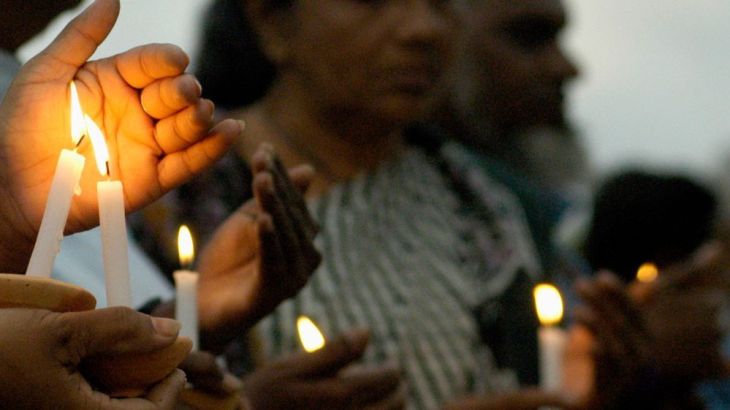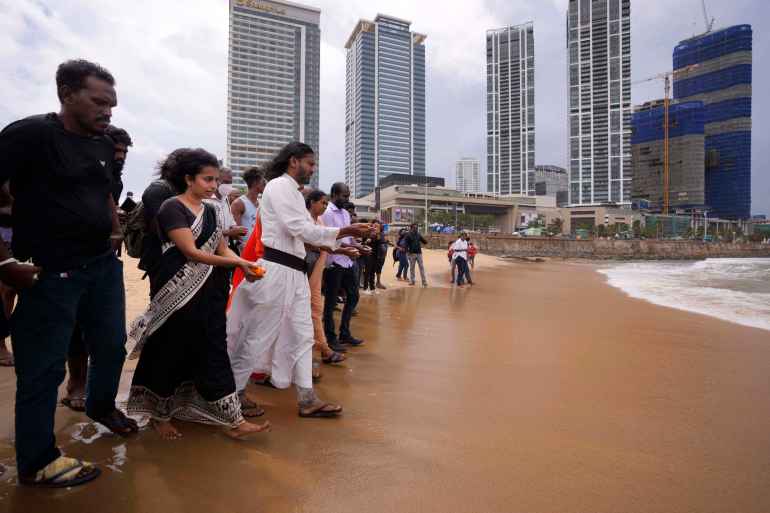What are Black July massacres that triggered Sri Lanka’s 26-year civil war?
Long-simmering ethnic tensions between the mainly Buddhist Sinhalese and the largely Hindu Tamil minority led to the civil war.

Forty years ago, mobs in Sri Lanka burned 13 people alive, part of a weeklong pogrom that caused simmering ethnic unrest to soon escalate into an all-out civil war.
Known in Sri Lanka as “Black July”, the brutal violence triggered a 26-year conflict that killed about 100,000 people, displaced about 800,000, and set development back by decades in the island nation.
Keep reading
list of 4 itemsWhy Sri Lankan Tamil refugees in India attempted mass suicide
Photos: War-ravaged Sri Lankan Tamils suffer amid economic crisis
How the UN failed Tamil civilians in 2009
The head of the separatist Tamil movement, Velupillai Prabhakaran, was shot dead by security forces on May 18, 2009, bringing a formal end to the bloody ethnic war.
What caused the civil war?
Ethnic tensions between the mainly Buddhist Sinhalese majority and the largely Hindu Tamil minority had long simmered, which worsened after the former colonial ruler Britain quit in 1948.
Despite the British rule marked by a divide-and-rule strategy, some Tamils were appointed to high-ranking civil services jobs and played an important role in the island’s governance.
However, administrative power in 1948 fell into the hands of the Sinhalese, who began a policy of discrimination against the Tamil minority.
The Ceylon Citizenship Act of 1948 denied Tamils citizenship because of their Indian descent. In 1956, the Sinhala Only Act made Sinhalese the only official language of Sri Lanka. In the 1970s, importing Tamil language books, magazines and films from India’s Tamil Nadu state was also outlawed.
Growing calls among Tamils for the right to self-determination were brushed aside in 1977 when the Sri Lankan government passed an amendment to the constitution, prohibiting peaceful advocacy of independence.
Four years later, an irreversible blow to Tamil culture and history at the hands of an organised Sinhalese mob saw a library in Jaffna set on fire in 1981. More than 95,000 Tamil historical texts and manuscripts were burned to ashes.
What happened in July 1983?
The conflict erupted when a landmine ambush laid by Tamil rebels killed 13 Sinhalese soldiers of the Sri Lankan army in the Tamil heartland of Jaffna in the north.
The government flew the bodies to capital Colombo for a mass burial, but relatives demanded individual funerals and anti-Tamil riots began.
The backlash degenerated into a week of violence targeting Tamils, with the worst of the violence on July 29, dubbed the “Black Friday”.
According to the government, 400 to 600 people died over the course of the massacres – mostly Tamils. But minority groups say the true toll could be in the thousands.
“The events that happened … changed the course of history,” said Tamil legislator MA Sumanthiran.
“We don’t regard what happened in 1983 as a riot, because it was planned violence unleashed on the Tamil people in this country. It was a pogrom.”

Some claim the army was actively involved or provided tacit support to the attacks in revenge for the loss of their 13 comrades, and several then-government officials were seen leading mobs.
No one has been prosecuted.
What do the survivors say?
The 1983 anti-Tamil mob attacks escalated on July 29, when Mohan Panneer Selvam was just eight years old.
A rampaging gang torched his home in the tea-growing central town of Hawa Eliya, burning 13 people inside, including his parents, relatives and their staff.
“My grandmother started to escape, they shot her and threw her body into the house,” Panneer Selvam said, breaking down while recalling the events narrated to him by his older sister.
He and his younger brother were away at boarding school when the riots broke out, returning as orphans to the ruins of their burned home two months later.
His sister – then a child of 10 – was the sole survivor only because their mother “threw her out of the kitchen window,” he said.
She was wounded and found “two or three days later” by police and sent to a camp for Tamils made homeless by the violence.
“My sister saw the burned bodies – they put the bodies in a municipal tractor [trailer],” he told the AFP news agency. “They dumped them somewhere.”
What is the civil war’s legacy?
Human rights lawyer Nimalka Fernando, who is a Sinhalese, said autonomy was the “political standard of the Tamil people”, noting they had always voted for a federal system – and had even demanded a separate state during elections in 1977.
“To quell that, to subdue that, violence was practised,” he said. “So ’83 was the height of that kind of strategy by the government.”
Legislator Sumanthiran says about 1.3 million Tamils fled the country after the riots, many north to neighbouring India – motivating their increasing interest in the conflict.
New Delhi pressed Colombo to seek peace by granting autonomy to the Tamils, and the Sinhalese leaders’ policy “boomeranged” back in their faces, he added.
“While everything was on fire, the Indian government intervened,” Sumanthiran said.
Of the estimated 100,000 killed in the war, the dead are split roughly equally between the security forces, Tamil fighters and Tamil civilians, with Sinhalese and Muslims also among the dead.
“Over 40 years, it has been a journey to grapple with waves of internally displaced people, waves of refugees in my own country,” Fernando said.
The physical scars of the war fade, and only a few of the battle-scarred buildings remain. But the legacy of events 40 years ago lives on.
Today, Sumanthiran said many Tamils still dream of political autonomy.
“Successive governments after the war ended have been successful in sort of delaying it – promising and not doing,” he said. “But I don’t think they can do that for too long.”